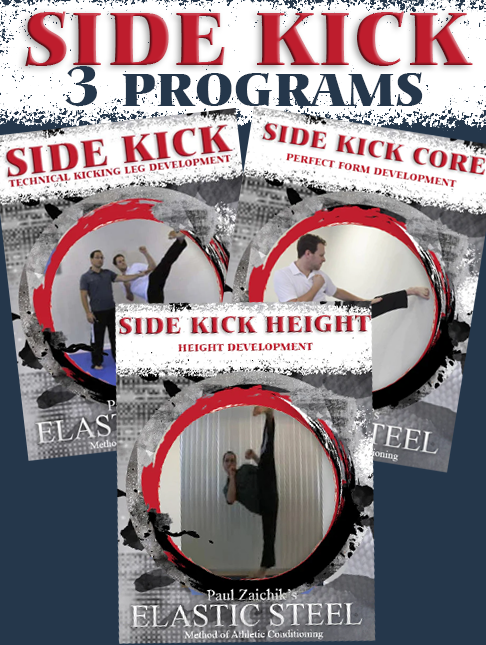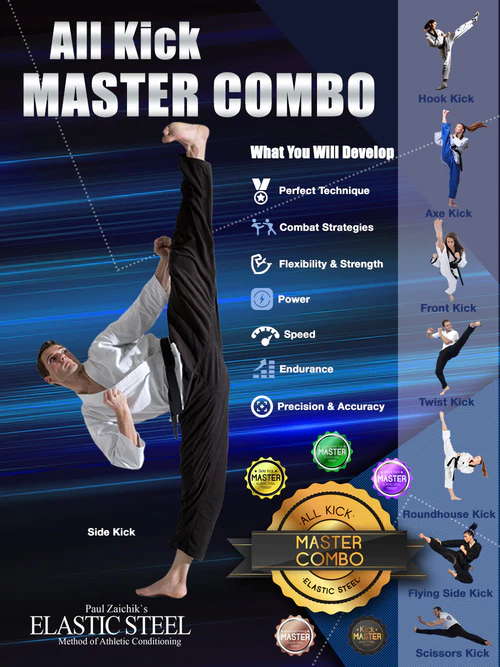Sidekick Target penetration versus target displacement
Sidekick Target Penetration versus Target Displacement.
Sidekick Target penetration versus target displacement. Martial arts side kick is a very interesting kick. Done properly, it can either make your opponent grow wings and fly or make your opponent drop on the spot.
Pushing Side Kick vs Penetrating Side Kick: The difference between the two kicks and how they are performed.
The difference between the two kicks and how they are performed. Is the topic of this article. There are several differences between a pushing sidekick and a penetrating sidekick. Regardless which martial arts you practice, if a sidekick is in your arsenal, whether you do karate, taekwondo, kung fu, kickboxing or any other style, it makes sense to learn how to do both variations of the kick.
Before going into how each kick is performed for its specific goal penetration versus displacement. A quick discussion about the purpose of each type of the kick is necessary. A pushing side kick would simply push the person away, usually off balance. In sparring it can create distance.
On the street this kick can also create distance, but at the same time it can show an attacker that you mean business, without actually hurting them. Especially if this is a situation where the attacker does not need to be hurt. A penetrating side kick does not aim to push an attacker away. The goal of a penetrating side kick is to get your foot deep into the body, usually striking internal organs. This type of a side kick is aimed to inflict damage or to quickly end a confrontation.
Before going into how each kick is performed for its specific goal penetration versus displacement. A quick discussion about the purpose of each type of the kick is necessary. A pushing side kick would simply push the person away, usually off balance. In sparring it can create distance.
On the street this kick can also create distance, but at the same time it can show an attacker that you mean business, without actually hurting them. Especially if this is a situation where the attacker does not need to be hurt. A penetrating side kick does not aim to push an attacker away. The goal of a penetrating side kick is to get your foot deep into the body, usually striking internal organs. This type of a side kick is aimed to inflict damage or to quickly end a confrontation.
Side Kick Combo
This combo will take you to kicking a perfectly controlled side kick above head level and being able to hold it there just like you hold your arm up.
Paul Zaichik and his team have been perfecting Martial Arts training, and here we bring you all this distilled knowledge to make you and unstoppable kicking machine.
The applicable situation for a penetrating sidekick in a self-defense situation
The applicable situation for a penetrating sidekick in a self-defense situation is when an opponent is 100% dedicated to hurting you or someone else. You know that the situation is such that if you do damage, you will not be legally responsible because this is clearly a self-defense situation. At the same time, if an opponent has a weapon or you're faced with multiple opponents and you may only get one chance to land a clean shot, which will allow you to disable an armed attacker. Or perhaps if you are attacked by two people. Disabling one, allows you to concentrate on the other one. And again, providing that legally you are in the right. You can use a penetrative side kick.
The difference is now between how the kicks are performed, what they look like.
The difference is now between how the kicks are performed, what they look like. Usually a side kick that aims to push away will use as large part of the foot as possible. Perhaps, even the whole sole of the foot.
While the side kick that aims to penetrate will use a small area of the impact, as small as possible, usually just the heel. The target selection for the two are usually different. Chest or ribs (not the floating ribs) is a good target for a displacing side kick.
On the other hand, liver, spleen, solar plexus, bladder, are all good targets for the penetrative side kick. Sometimes a target for the penetrative side kick is chosen in such a way that it is only the heel that is in line with the kick, but not the rest of the foot. In other words, if you throw a side kick aiming to penetrate with a heel to the stomach, eventually, once the heel goes in, the rest of the foot will stop the kick because it will make contact.
But if then let's say you kick them with the right leg and the kick is a little bit to your opponent's right side, the toes will now intentionally miss and not slow down the penetration of the kick. It's usually the side kick that aims to push an opponent away or off balance and has more of a thrust with the bodyweight pushing after the kick connects. A side kick that aims to penetrate, usually the kick is accelerated and the body grounds itself more, through the supporting leg to allow the force to be transferred into the kicking leg.
While the side kick that aims to penetrate will use a small area of the impact, as small as possible, usually just the heel. The target selection for the two are usually different. Chest or ribs (not the floating ribs) is a good target for a displacing side kick.
On the other hand, liver, spleen, solar plexus, bladder, are all good targets for the penetrative side kick. Sometimes a target for the penetrative side kick is chosen in such a way that it is only the heel that is in line with the kick, but not the rest of the foot. In other words, if you throw a side kick aiming to penetrate with a heel to the stomach, eventually, once the heel goes in, the rest of the foot will stop the kick because it will make contact.
But if then let's say you kick them with the right leg and the kick is a little bit to your opponent's right side, the toes will now intentionally miss and not slow down the penetration of the kick. It's usually the side kick that aims to push an opponent away or off balance and has more of a thrust with the bodyweight pushing after the kick connects. A side kick that aims to penetrate, usually the kick is accelerated and the body grounds itself more, through the supporting leg to allow the force to be transferred into the kicking leg.
Biomechanically
Biomechanically, the speed of the mass, total mass or acceleration of the total mass is more important in the pushing kick. While the end acceleration, which is basically a chain that travels from the body to the kicking leg, is more important in a penetrative kick. The mass accelerates, but then the focus becomes on a kick in leg.
Velocity at the moment of impact.
Velocity at the moment of impact. Granted, the muscles used are different and the technique is different between a punch and a kick. But if you're more of a beginner student. And you're more comfortable with your punching techniques than with your kicking technique, you may think of how you throw a punch that you aim to penetrate.
Side Kick Combo
This combo will take you to kicking a perfectly controlled side kick above head level and being able to hold it there just like you hold your arm up.
Paul Zaichik and his team have been perfecting Martial Arts training, and here we bring you all this distilled knowledge to make you and unstoppable kicking machine.
Some legal words of caution
Some legal words of caution. If you decide to use a kick. Make sure that the situation completely calls for it. Not because someone has insulted you or your friend or you decided to show off or something similar.
It's important to understand that once you throw this kick at someone. The end result may be different than what you intended. And in court you will be judged by the end result and not by your intention based on many case studies.
So if you do a side kick to someone just to push them away or to let them know that you mean business and they end up flying and injuring themselves, your intent that you simply wanted to push them away and let them know not to start trouble. Is going to be less important in court than the damage that you have done to them.
So it's very important to keep that in mind. The other thing that I would like to say about this is that having done Martial Arts for a long time, I could tell you that there are a lot of people that want to test if their techniques work in a situation where the techniques should not be tested.
For example, if you are preparing for a fight. And you were having a friendly sparring match with your schoolmates. It's not a good time to check if your power kick works or not. And a lot of people do that. They go full power just to see how strong their kick is on unsuspecting teammates. There are better and safer ways, such as by hitting targets designed for this purpose. Breaking items designed for this purpose. And so on. Enjoy your kicking.
It's important to understand that once you throw this kick at someone. The end result may be different than what you intended. And in court you will be judged by the end result and not by your intention based on many case studies.
So if you do a side kick to someone just to push them away or to let them know that you mean business and they end up flying and injuring themselves, your intent that you simply wanted to push them away and let them know not to start trouble. Is going to be less important in court than the damage that you have done to them.
So it's very important to keep that in mind. The other thing that I would like to say about this is that having done Martial Arts for a long time, I could tell you that there are a lot of people that want to test if their techniques work in a situation where the techniques should not be tested.
For example, if you are preparing for a fight. And you were having a friendly sparring match with your schoolmates. It's not a good time to check if your power kick works or not. And a lot of people do that. They go full power just to see how strong their kick is on unsuspecting teammates. There are better and safer ways, such as by hitting targets designed for this purpose. Breaking items designed for this purpose. And so on. Enjoy your kicking.
ELASTICSTEEL MASTER KICKER COLLECTION

3 Program
Side Kick Combo
Side Kick Combo
This combo includes:
- Technical Kicking Leg Development
- Core Flexibility & Strength Development
- Height Development

7 Program
Side Kick Combo
Side Kick Combo
This combo includes:
- Technical Kicking Leg Development
- Core Flexibility & Strength Development
- Height Development
- Speed Development
- Precision & Accuracy Development
- Power Development
- Flying Side Kick

20 Program
All Kick Master Combo
+ 5 Gifts!
All Kick Master Combo
+ 5 Gifts!
This combo includes:
Side Kick:
- Technical Kicking Leg Development
- Core Flexibility & Strength Development
- Height Development
- Speed Development
- Precision & Accuracy Development
- Power Development
- Neutralizing Opponents Defense and Guard Penetration Set Ups
Roundhouse and Hook Kicks:
- Roundhouse Kick: Technical Kicking Leg Development
- Roundhouse Kick: Speed Development
- Roundhouse Kick: Power Development
- Hook Kick: Power Development
Front Kick:
- Front Kick and Front Line Kicks: Technical Kicking Leg Development
- Front Kick: Speed Development
- Push Front Kick: Power Development
- Axe Kick: Power Development
- Ball of the Foot: Point of Impact
Advanced Kicks:
- Scorpion Kick: Perfect form Development
- Flying Side Kick: Technique and Jumping Height Development
- Flying Split Scissors Kick, Two Direction Kick
- Twist Kick Technical Kicking Leg Development
- Twist Kick Follow Along Routine
+ 5 GIFTS!

About the Author:
Paul Zaichik is an Exercise Science Expert, author of multitude of books, and the creator of Zaichik Stretching Technique (formely known as Kinesiological Stretching Technique). His speciality is flexibility training as well as body weight conditioning. His innovative method is designed to have maximum carry over into specific athletic techniques. Paul is the author of books and DVD’s on the topic of flexibility, martial arts and bodyweight training. Over the years, Paul Zaichik has worked with a variety of individuals including athletes, entertainers, and military personnel. His ElasticSteel Method of Athletic Conditioning programs, EasyFlexibility Programs and Zaichik Stretching Techniques are used world wide by both professional and amateurs with great success.
© ElasticSteel Corp., EasyFlexibility, Paul Zaichik, et. El., 2022. No part of the materials available through ElasticSteel.com, EasyFlexiiblity.com, site may be copied, photocopied, reproduced, translated or reduced to any electronic medium or machine-readable form, in whole or in part, without prior written consent of Paul Zaichik EasyFlexibility.com, Elasticsteel.com.. Any other reproduction in any form without the permission of Paul Zaichik EasyFlexibility.com, Elasticsteel.com is prohibited. All materials contained on this site are protected by United States copyright law and may not be reproduced, distributed, transmitted, displayed, published or broadcast without the prior written permission of Paul Zaichik, EasyFlexibility.com, Elasticsteel.com.



Leave a comment